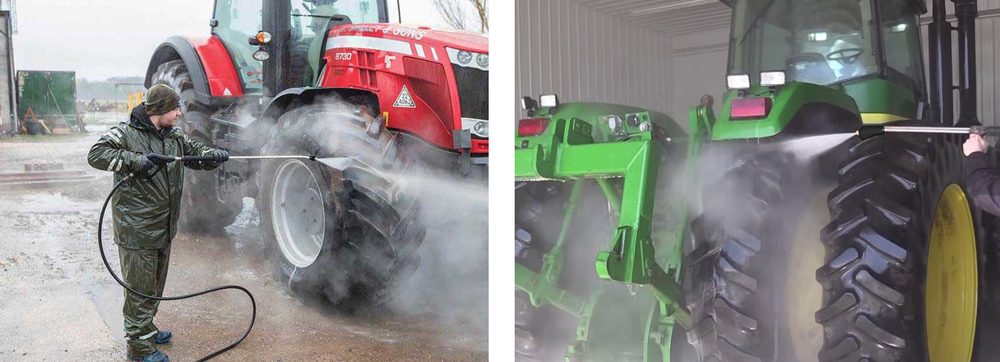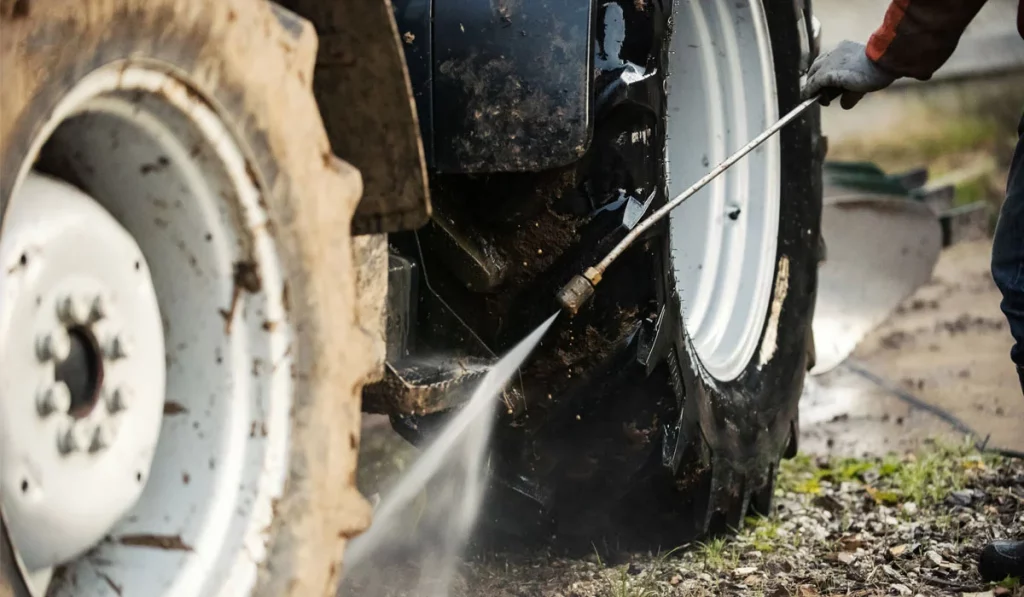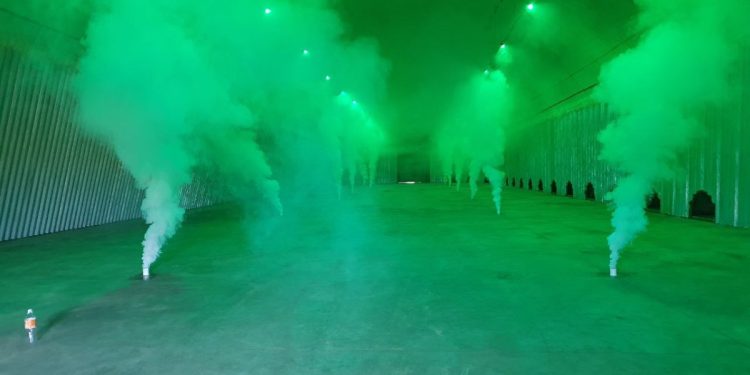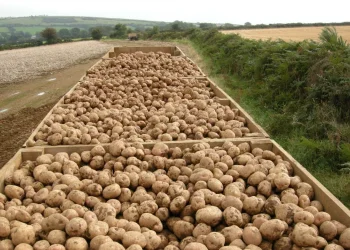Cleaning and disinfectant can help prevent spread of the following potato diseases:
In fields, spread by contaminated equipment Most problem pests can be effectively eliminated by removing all soil and debris from field equipment before they leave one field and enter another. Harvesters retain the most soil, followed by plows and then cultivators.
Pests that can spread include:
• Nematodes
• Weed seeds
• Soil-borne diseases
Seed cutter (machine) is a common source of contamination for:
• Bacterial ring rot—caused by Clavibacter michiganese
• Bacterial soft rot—caused by Pectobacterium spp.
• Fusarium dry rot—caused by Fusarium sp.
• Late blight—caused by Phytophthora infestans
• Mechanically transmitted viruses such as potato virus X (PVX)
Pick planters are worse than cup planters for transmitting potato diseases because the picks are easily contaminated during planting, spreading disease from infected to healthy seed pieces.
In potato storage units where pests can survive for years Storage cleaning and disinfection is important to minimize disease carryover from one season to the next, especially in storage facilities that had tuber breakdown due to rot or “hotspots” where tuber decay had occurred the previous storage season. Potato pathogens can survive very long times in potato storages.
Silver scurf—caused by the fungus Helminthosporium solani — can survive
• At least 9 months on foam insulation and soil floors
• 3 months in plywood and sheet metal
Bacterial ring rot can survive
• Up to 3 years on hard surfaces
• Up to 7 years on wood surfaces

Potato equipment and storages are exposed to a number of pests including fungi, bacteria, insects, nematodes, and weed seeds. Many of these pests can be spread from tuber to tuber or field to field on equipment or in storage and cause problems in future crops if not eliminated or at least minimized. Some disease problems, like bacterial ring rot (caused by Clavibacter michiganese), can be a very serious problem for seed potato producers, even when the disease occurs at very low levels. Nematodes are easily transferred from one field to another in soil adhering to equipment that is not properly cleaned between fields.
One of the best methods to minimize spread or recurrence of a pest is a good sanitation program for equipment and storage facilities. Equipment is often moved from field to field or even shared among growers, a practice that makes cleaning and disinfecting even more critical. This problem is not limited to private farms. The same issues also apply to custom operations and the purchase of used equipment. It is imperative that all equipment be thoroughly cleaned and sanitized prior to movement into your fields for the first time. If there are known pest concerns in fields within your farming operation, it is advisable to clean equipment prior to and after movement between fields.
The terms “cleaning and disinfecting” are defined and emphasized throughout this bulletin. The simple act of cleaning is a key first step to a highly effective overall
disinfection program.
- Cleaning refers to the physical removal of soil and debris by sweeping, shoveling, or scraping prior to utilizing a water-and-soap-based detergent program or
- using some sort of steam appliance.
- Soap-based detergents are important because they can break apart dried bacterial slime and plant sap or other deposits. The breakdown of these deposits often
- destroys the pathogens directly or degrades the material protecting these pathogens, which helps facilitate a more thorough disinfection of equipment and/or storage facilities.
- The cleaning process also removes potato debris and other trash from within and around storage facilities, which has the added benefit of reducing or eliminating
- foreign material from the next stored crop.
- Prior to disinfecting equipment or a storage facility, removal of debris and soil is also necessary to allow the disinfectant to be effective. This is very important because general disinfectants or biocides are very reactive with organic matter such as soil and debris.
If these contaminants are present in high quantities on the surface you are attempting to disinfect, the disinfectant will not perform well enough. Simply applying a disinfectant without an effective overall cleaning beforehand is not recommended.

Cleaning and disinfecting field and handling equipment
- Removal of soil and debris One of the most critical problems associated with contaminated equipment is soil. Most problem pests can be effectively eliminated by removing all soil and debris.
Keep in mind that adhering soil is a problem in all field preparation and tillage equipment and is not just limited to dedicated potato handling equipment. The
amount of soil remaining on a piece of equipment varies with the type of equipment. Cultivators generally retain less soil than plows, which, in turn, retain less soil than harvesters.
- The number one objective for equipment that is to be cleaned and disinfected is to completely remove all soil. This task can be accomplished with pressurized water or with steam equipment. Be aware that either of these two methods can remove paint. Clean the equipment at the previous field site or take it to a non-farm site for cleaning so that contaminated soil is not moved to a new field.
- Note: Removing contaminated soil at a non-farm site is a very important practice to follow when purchasing, leasing, or borrowing used equipment.
- Seed cutting and pick-style planting equipment A seed cutter is a common source of contamination for bacterial ring rot, bacterial soft rot (caused by Pectobacterium spp.), Fusarium dry rot (caused by Fusarium sp.), late blight (caused by Phytophthora infestans) and, to a lesser extent, mechanically transmitted viruses such as potato virus X (PVX). This occurs because the cutting blades are in use continuously during the cutting process transmitting sap, debris, and the associated pathogens from infected seed tubers to healthy ones. This highly effective mechanical transmission of seed decay and other pathogens dictates a strong and directed cleaning and disinfection of all cutting blades.

At the very least, cleaning and disinfection procedures need to be employed between seed lots. The potential for contamination from one seed piece to another is greater with a pick style planter compared to a cup planter. This is because picks are inserted into individual seed pieces causing a puncture wound. When picks are inserted into a diseased potato, they may become infested with single or multiple pathogens, which are then spread to other non-infected seed pieces.
- Cleaning and disinfecting of the picks in conjunction with replacing old and worn picks prior to the beginning of the planting season will help decrease disease spread from one year to the next. Cleaning and disinfection during the current planting season is more difficult. If a seed lot has a pathogen concern—a known disease problem—then cleaning and disinfecting the picks between seed lots is recommended.







